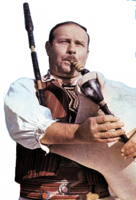
|
The Society of Folk Dance Historians (SFDH) Pece Atanasovski
[
Home |
About |
Encyclopedia | CLICK IMAGE TO ENLARGE |

|
BACKGROUND
Information: Macedonian and Bulgarian musician and teacher of Macedonian dance.
Petre Vasilev "Pece" Atanasovski was born on October 25, 1927, in the village of Dolneni (near Prilep), Macedonia, the son of Vasile Ananasov Todorovski. It was the tradition until World War II for a male child to have his second name his father's, and his last name his grandfather's. Thus Pece is "Petre, son of Vasile, son of Atanas." Since the war, however, custom has changed and everone in a family has the same last name. Pece grew up in Dolneni, in a household with nine other children, and lived there until 1944. As a child, he was a shepherd and attended school only through the fourth grade. After that, he would have had to go to Prilep to continue his schooling and his parents would have had to pay. Even so, he was probably more fortunate than many other boys his age, who never learned to read and write.
He began playing instruments at the age of 5 or 6. Many of the men in his family were good musicians on the gajde, kaval, or šupelka, and Pece learned to play all of these instruments, although at first he only played the surla (chanter) part of the gajda.
From 1944 to 1947, Pece served in the army, then went to Skopje, where he worked as a salesman for a clothing factory. At this time, he also was able to complete his schooling through eighth grade and even begin study at a music high school.
During this period, Pece was active as a dancer in various amateur ensembles around Skopje. He also led his own village's group at various festivals in 1947. At the end of the War, there was a resurgence of national feeling. There were a number of festivals of village groups. Traditional costume was still worn and traditional dances and songs regularly performed in most Macedonian villages.
In 1950, Pece joined the then-forming state dance ensemble "Tanec" as well. He traveled throughout the world with the group, including a trip to the United States, and remained with the ensemble until 1959.
From 1960 on, he was director of the "Orchestra of Folk Instruments of Radio-Televizia-Skopje." This orchestra, a group of about a half-dozen musicians, which had never actually occurred among the "folk," was at first begun in 1950 as a part of "Tanec" under the direction of a professor of ethnomusicology, Dr. Živko Firfov, and often played on the radio in the 1950s. Working closely with Dr. Firfov, Pece established a standard for the Macedonian izvorni (traditional instruments) that became a trademark of radio progams and recordings, both as instrumental pieces and as backup for famous folk singers. In addition to directing this orchestra, Pece was the artistic director of the amateur "Makedonija" Folk Ensemble and frequently traveled to Bitola, Prilep, and abroad as a paid consultant to local dance groups.
Pece also discovered and introduced many village singing groups who were recorded and heard on radio. Some of these were Bapčorki, the Kumanovsko Trio, Kvintet Temjanuški, and Trio Kučkovski.
In 1967, Pece toured the United States as a gajda player with "Lado." Beginning in 1970, Pece and Dr. Firfov held annual ten-day seminars each summer on the dances and songs and folklore of Macedonia at Oteševo at Lake Prespa. These seminars were attended by many folklore enthusiasts from North America, Western Europe, and Japan.
In 1972, Pece toured North America for the first time on his own, and many of his original dances he taught became classics in the international recreational repertoire.
Pece recorded with several musical groups and produced fine recordings of Macedonian dance music which are available from your local folk dance recording outlet. Outstanding CDs and matching videos of Pece are available from BMA Productions (Canada). The 47 musical selections found on these two CDs are original master recordings licensed from Croatia Records (formerly Jugoton), and RTB (RTS Beograd) and were released in Germany in 2003 by Verlag Happ. Yves Moreau and BMA obtained special permission from Verlag Hepp to press these CDs in Canada for distribution and sale in North America. The recordings feature the Pece Atanasovski Orchestra with Pece on gajda and his fantastic musicians accompanying him with many solos on kaval and tambura. There are also several tracks with zurla and tapan, calgija orchestra, clarinet, accordion, and Aegean Macedonian brass band. The technical quality is excellent both for dancing and listening.
Among Pece's publications is
- Macedonian Folk Dances (published by Snark Records), presented by Pece Atanasovski with dance notes by Robert Leibman, Department of Folklore at UCLA.
Other teachers, such as Michael Ginsburg, Steve Kotansky, Paul Mulders, Dick Oakes, and Larry Weiner have taught Pece's material to recreational folk dancers.
Pece, who passed away from a heart attack on September 19, 1996, is survived by his wife Cena and two daughters, Vesna and Suzana.
Dances Pece taught include Adana, Baba Džurdža, Beranče, Berovka, Buvčansko, Crnogorka, Čučuk Oro, Čupurlika, Devojče, Dolgoto Oro, Dračevka, Gorno Dumajsko Oro, Jeni Jol, Kalajžisko, Kavardaka, Kopačka, Krivo Žensko Oro, Kucano Oro, Maleševsko Oro, Marinino Oro, Maško Beranče, Maškoto Oro, Nevestinsko Oro, Odeno Oro, Ovčepolska Osogovka, Ovčepolska Potrčulka, Ovčepolsko Oro, Pajduško Oro, Patrunino, Posednica, Postupano Oro, Potrčano Oro, Pravo Oro, Pravoto (Lesnoto), Ratevka, Sitna Lisa, Skudrinka, Staro Oro, Staro Tikveško, Staro Žensko Krsteno, Teša Krstačka, Teškoto, Topansko Oro, Toska/Memede, Tropnalo Oro, Zborskoto, Žensko Beranče, Žensko Čamče, Žensko Krivoto, Žensko Pušteno Oro, and Zevovskoto.
This page © 2018 by Ron Houston.
Please do not copy any part of this page without including this copyright notice.
Please do not copy small portions out of context.
Please do not copy large portions without permission from Ron Houston.